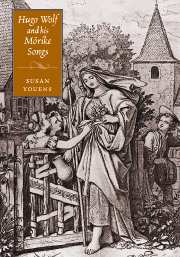Book contents
- Frontmatter
- Contents
- List of illustrations
- Preface
- Chapter 1 “Göttlicher Mörike!”: an introduction to Eduard Mörike and Hugo Wolf
- Chapter 2 Peregrina revisited: songs of love and madness
- Chapter 3 Agnes's songs: the fictional misfortunes and musical fortunes of a nineteenth-century madwoman
- Chapter 4 Sung desire: from Biedermeier erotica to fin-de-siècle lied
- Chapter 5 Doubters and believers: case-studies in the geistliche Lieder
- Notes
- Select bibliography
- Index
Chapter 5 - Doubters and believers: case-studies in the geistliche Lieder
Published online by Cambridge University Press: 22 September 2009
- Frontmatter
- Contents
- List of illustrations
- Preface
- Chapter 1 “Göttlicher Mörike!”: an introduction to Eduard Mörike and Hugo Wolf
- Chapter 2 Peregrina revisited: songs of love and madness
- Chapter 3 Agnes's songs: the fictional misfortunes and musical fortunes of a nineteenth-century madwoman
- Chapter 4 Sung desire: from Biedermeier erotica to fin-de-siècle lied
- Chapter 5 Doubters and believers: case-studies in the geistliche Lieder
- Notes
- Select bibliography
- Index
Summary
Song is a compound art, and its words and music often have their own large tales to tell, sometimes ones that intersect, sometimes ones that set off on radically different paths. After the eighteenth-century resurgence of song, with composers for the most part setting the poetry around them (Goethe, Claudius, Hölty), Romantic song composers discovered the delights of disjunction, such as the appropriation of Minnesong texts, or other poetic repertoires hailing from different times, places, purposes, and points of view, for contemporary use. Occasionally, the attempted merger of entities was too grotesque, oil and water that refused to be combined, as when Anton von Spaun (the brother of Schubert's friend Joseph von Spaun) in 1840 set the opening stanzas of the Nibelungenlied to the music of various folk dances in an attempt to prove Austrian authorship of the medieval masterpiece, but if the composer was sufficiently skillful, music could and did take unto itself words from eras not its own. Wolf even asserted that certain earlier poetic works had to await a later time before successful musical setting was possible; if there is a certain self-justificatory tone evident in the assertion and the ever-present sense of competition with Schubert (settings of Goethe were the issue), he was able on occasion to demonstrate that the proposition had merit.
In devotional songs, for which there was a large market in the nineteenth century, there was the possibility of still other disjunctions, with complex consequences.
- Type
- Chapter
- Information
- Hugo Wolf and his Mörike Songs , pp. 140 - 168Publisher: Cambridge University PressPrint publication year: 2000

